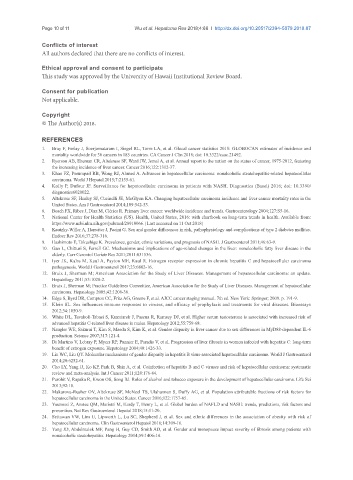Page 745 - Read Online
P. 745
Page 10 of 11 Wu et al. Hepatoma Res 2018;4:66 I http://dx.doi.org/10.20517/2394-5079.2018.87
Conflicts of interest
All authors declared that there are no conflicts of interest.
Ethical approval and consent to participate
This study was approved by the University of Hawaii Institutional Review Board.
Consent for publication
Not applicable.
Copyright
© The Author(s) 2018.
REFERENCES
1. Bray F, Ferlay J, Soerjomataram I, Siegel RL, Torre LA, et al. Glocal cancer statistics 2018: GLOBOCAN estimates of incidence and
mortality worldwide for 36 cancers in 185 countries. CA Cancer J Clin 2018; doi: 10.3322/caac.21492.
2. Ryerson AB, Eheman CR, Altekruse SF, Ward JW, Jemal A, et al. Annual report to the nation on the status of cancer, 1975-2012, featuring
the increasing incidence of liver cancer. Cancer 2016;122:1312-37.
3. Khan FZ, Perumpail RB, Wong RJ, Ahmed A. Advances in hepatocellular carcinoma: nonalcoholic steatohepatitis-related hepatocellular
carcinoma. World J Hepatol 2015;7:2155-61.
4. Kolly P, Dufour JF. Surveillance for hepatocellular carcinoma in patients with NASH. Diagnostics (Basel) 2016; doi: 10.3390/
diagnostics6020022.
5. Altekruse SF, Henley SJ, Cucinelli JE, McGlynn KA. Changing hepatocellular carcinoma incidence and liver cancer mortality rates in the
United States. Am J Gastroenterol 2014;109:542-53.
6. Bosch FX, Ribes J, Díaz M, Cléries R. Primary liver cancer: worldwide incidence and trends. Gastroenterology 2004;127:S5-16.
7. National Center for Health Statistics (US). Health, United States, 2016: with chartbook on long-term trends in health. Available from:
https://www.ncbi.nlm.nih.gov/pubmed/28910066. [Last accessed on 11 Oct 2018]
8. Kautzky-Willer A, Harreiter J, Pacini G. Sex and gender differences in risk, pathophysiology and complications of type 2 diabetes mellitus.
Endocr Rev 2016;37:278-316.
9. Hashimoto E, Tokushige K. Prevalence, gender, ethnic variations, and prognosis of NASH. J Gastroenterol 2011;46:63-9.
10. Gan L, Chitturi S, Farrell GC. Mechanisms and implications of age-related changes in the liver: nonalcoholic fatty liver disease in the
elderly. Curr Gerontol Geriatr Res 2011;2011:831536.
11. Iyer JK, Kalra M, Kaul A, Payton ME, Kaul R. Estrogen receptor expression in chronic hepatitis C and hepatocellular carcinoma
pathogenesis. World J Gastroenterol 2017;23:6802-16.
12. Bruix J, Sherman M; American Association for the Study of Liver Diseases. Management of hepatocellular carcinoma: an update.
Hepatology 2011;53:1020-2.
13. Bruix J, Sherman M; Practice Guidelines Committee, American Association for the Study of Liver Diseases. Management of hepatocellular
carcinoma. Hepatology 2005;42:1208-36.
14. Edge S, Byrd DR, Compton CC, Fritz AG, Greene F, et al. AJCC cancer staging manual. 7th ed. New York: Springer; 2009. p. 191-9.
15. Klein SL. Sex influences immune responses to viruses, and efficacy of prophylaxis and treatments for viral diseases. Bioessays
2012;34:1050-9.
16. White DL, Tavakoli-Tabasi S, Kuzniarek J, Pascua R, Ramsey DJ, et al. Higher serum testosterone is associated with increased risk of
advanced hepatitis C-related liver disease in males. Hepatology 2012;55:759-68.
17. Naugler WE, Sakurai T, Kim S, Maeda S, Kim K, et al. Gender disparity in liver cancer due to sex differences in MyD88-dependent IL-6
production. Science 2007;317:121-4.
18. Di Martino V, Lebray P, Myers RP, Pannier E, Paradis V, et al. Progression of liver fibrosis in women infected with hepatitis C: long-term
benefit of estrogen exposure. Hepatology 2004;40:1426-33.
19. Liu WC, Liu QY. Molecular mechanisms of gender disparity in hepatitis B virus-associated hepatocellular carcinoma. World J Gastroenterol
2014;20:6252-61.
20. Cho LY, Yang JJ, Ko KP, Park B, Shin A, et al. Coinfection of hepatitis B and C viruses and risk of hepatocellular carcinoma: systematic
review and meta-analysis. Int J Cancer 2011;128:176-84.
21. Purohit V, Rapaka R, Kwon OS, Song BJ. Roles of alcohol and tobacco exposure in the development of hepatocellular carcinoma. Life Sci
2013;92:10.
22. Makarova-Rusher OV, Altekruse SF, McNeel TS, Ulahannan S, Duffy AG, et al. Population attributable fractions of risk factors for
hepatocellular carcinoma in the United States. Cancer 2016;122:1757-65.
23. Younossi Z, Anstee QM, Marietti M, Hardy T, Henry L, et al. Global burden of NAFLD and NASH: trends, predictions, risk factors and
prevention. Nat Rev Gastroenterol Hepatol 2018;15:11-20.
24. Setiawan VW, Lim U, Lipworth L, Lu SC, Shepherd J, et al. Sex and ethnic differences in the association of obesity with risk of
hepatocellular carcinoma. Clin Gastroenterol Hepatol 2016;14:309-16.
25. Yang JD, Abdelmalek MF, Pang H, Guy CD, Smith AD, et al. Gender and menopause impact severity of fibrosis among patients with
nonalcoholic steatohepatitis. Hepatology 2014;59:1406-14.

